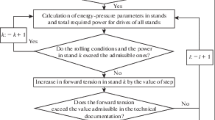Abstract
In the process of cold tandem rolling, chatter instability leads to serious impacts on enhancing rolling speed, improving product quality, reducing production cost and realizing intellectualization. Chatter occurs with the rolling speed up to a certain threshold value, but the critical speed is determined by both product specifications and rolling schedules. A 5-stand cold tandem rolling mill whose first three stands and subsequent two stands, respectively, have four and six rolls was investigated by formulating its dynamic equations with the corresponding structure–process coupling. By applying the stability-based calculation model about the critical rolling speed in each stand, the system dynamic responses around the critical rolling speed were simulated, and the system eigenvalues which represent instability and characteristic frequencies were figured out. Thereafter, via combining the critical rolling speeds with the system dynamic behavior, a dynamics-based optimization model of rolling schedule for the 5-stand cold tandem system was proposed for the purposes of both the chatter suppression and rolling speed increase. In the optimization model, eight rolling technique parameters (four strip thicknesses and four tensions between the upstream and downstream stands) were taken as design variables, and the constraint conditions were set as no chatter instability in all five stands, and the optimization goal was to maximize the outlet speed of the final stand. The pattern search method was introduced to solve the optimization model. By applying such a dynamics-based optimization model for the 5-stand cold tandem rolling process, the chatter instability was suppressed effectively and the rolling efficiency was improved considerably; therefore, such an optimization model is expected to be valuable for intelligent manufacturing of rolling process.












Similar content being viewed by others
References
G.F. Bryant, Automation of tandem mills, Iron and Steel Institute, London, UK, 1998.
M. Poursina, N.T. Dehkordi, A. Fattahi, H. Mirmohammadi, Simulat. Model Pract. Theory 22 (2012) 61–73.
J.M. Yang, H.J. Che, Y.J. Xu, F.P. Dou, in: J. Wang, Z. Yi, J.M. Zurada, B.L. Lu, H. Yin (Eds.), Advances in Neural Networks - ISNN 2006. ISNN 2006, Lecture Notes in Computer Science, Vol. 3973, Springer, Berlin, Heidelberg, 2006, pp. 864–869.
J.M. Yang, Q. Zhang, H.J. Che, X.Y. Han, J. Iron Steel Res. Int. 17 (2010) No. 11, 34–39.
C.T.A. Pires, H.C. Ferreira, R.M. Sales, M.A. Silva, J. Mater. Process. Technol. 173 (2006) 368–375.
S.Z. Chen, X. Zhang, L.G. Peng, D.H. Zhang, J. Sun, Y.Z. Liu, J. Cent. South Univ. 21 (2014) 1733–1740.
D.J. Kim, Y.C. Kim, B.M. Kim, J. Mater. Process. Technol. 113 (2001) 131–135.
H.Q. Liu, Q. Yang, D. Tang, H.T. Bian, J. Iron Steel Res. 20 (2008) No. 1, 54–58.
Y. Li, L. Fang, J. Iron Steel Res. Int. 24 (2017) 795–802.
J.M. Yang, H.J. Che, F.P. Dou, T. Zhou, J. Iron Steel Res. Int. 15 (2008) No. 2, 18–22.
A. Heidari, M.R. Forouzan, J. Adv. Res. 4 (2013) 27–34.
P.H. Hu, H. Zhao, K.F. Ehmann, J. Eng. Manuf. 220 (2016) 1267–1277.
M.R. Forouzan, I. Kiani, M.R. Niroomand, M. Salimi, Steel Res. Int. 79 (2008) 483–489.
M.R. Niroomand, M.R. Forouzan, M. Fasihfar, M. Salimi, Steel Res. Int. 81 (2010) 162–165.
X.D. Qi, T. Wang, H. Xiao, J. Iron Steel Res. Int. 19 (2012) No. 8, 25–28.
K. Prinz, A. Steinboeck, A. Kugi, J. Process Contr. 64 (2018) 100–111.
W. Peng, Y.F. Ji, X.R. Chen, D.H. Zhang, J. Northeast Univ. 40 (2019) 1408–1412.
D. Chen, J. Shao, S. Yin, Y.Q. Zhang, W. Zhang, T. Hu, Metall. Ind. Autom. 44 (2020) No. 6, 25–29+61.
Z.W. Jia, Y.H. Li, H.L. Zhang, X.L. Wang, Steel Rolling 37 (2020) No. 1, 42–44.
L.S. Fan, Z.H. Chen, J.Y. Zhu, Tool Engineering 54 (2020) No. 9, 75–77.
P.R. Prabhu, S.M. Kulkarni, S. Sharma, J. Mater. Res. Technol. 9 (2020) 11402–11423.
Y. Wang, C.S. Li, X. Jin, Y.G. Xiang, X.G. Li, J. Manuf. Process. 60 (2020) 257–267.
Z.Y. Gao, L.L. Bai, Q. Li, J. Mech. Eng. 53 (2017) 118–132.
Z.Y. Gao, Y. Liu, Q.D. Zhang, M.L. Liao, B. Tian, Mech. Syst. Signal Process. 140 (2020) 106692.
M.R. Niroomand, M.R. Forouzan, M. Salimi, M. Kafil, J. Vibroeng. 14 (2012) 852–865.
M.R. Niroomand, M.R. Forouzan, A. Heidari, Int. J. Adv. Manuf. Technol. 100 (2019) 673–682.
Acknowledgements
This work was supported by the National Natural Science Foundation of China (No. 51775038).
Author information
Authors and Affiliations
Corresponding author
Rights and permissions
About this article
Cite this article
Gao, Zy., Tian, B., Liu, Y. et al. Dynamics-based optimization of rolling schedule aiming at dual goals of chatter suppression and speed increase for a 5-stand cold tandem rolling mill. J. Iron Steel Res. Int. 28, 168–180 (2021). https://doi.org/10.1007/s42243-020-00551-5
Received:
Revised:
Accepted:
Published:
Issue Date:
DOI: https://doi.org/10.1007/s42243-020-00551-5




